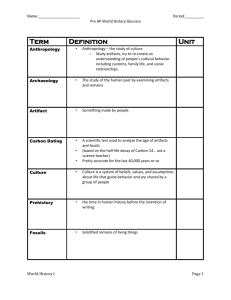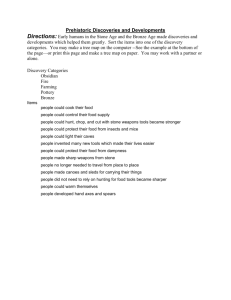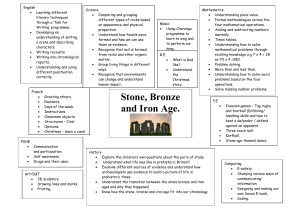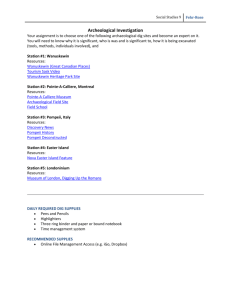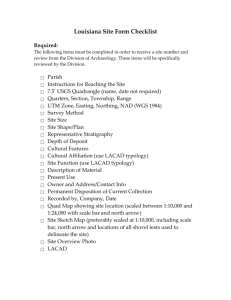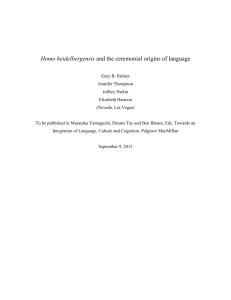Europanthropus heidelbergensis
advertisement
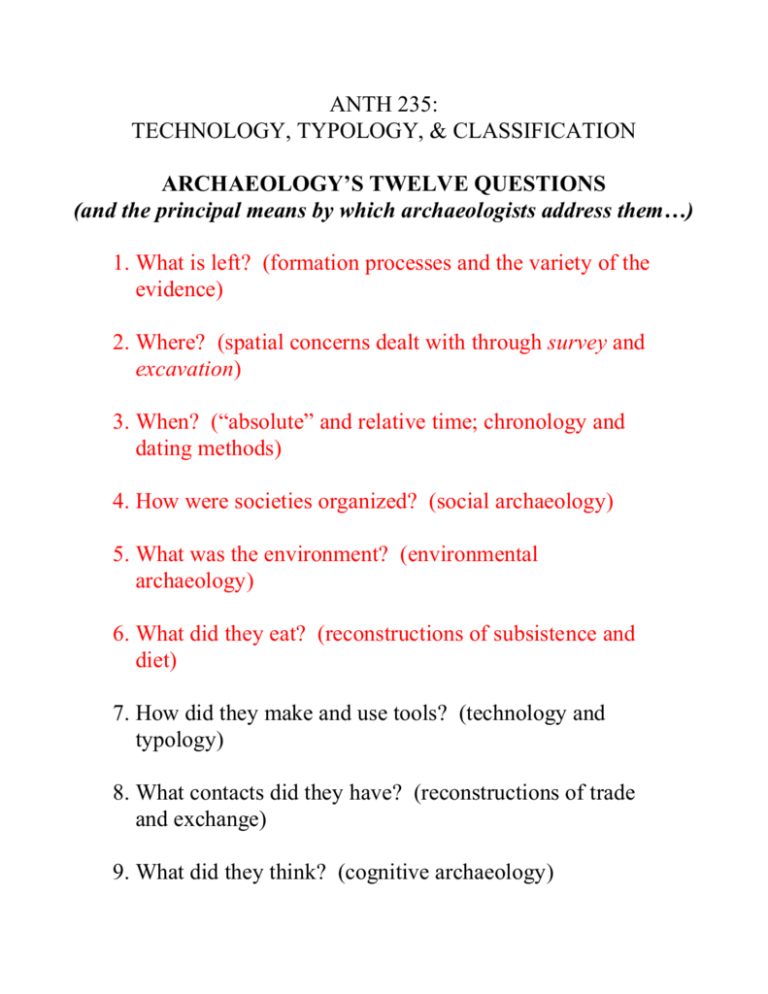
ANTH 235: TECHNOLOGY, TYPOLOGY, & CLASSIFICATION ARCHAEOLOGY’S TWELVE QUESTIONS (and the principal means by which archaeologists address them…) 1. What is left? (formation processes and the variety of the evidence) 2. Where? (spatial concerns dealt with through survey and excavation) 3. When? (“absolute” and relative time; chronology and dating methods) 4. How were societies organized? (social archaeology) 5. What was the environment? (environmental archaeology) 6. What did they eat? (reconstructions of subsistence and diet) 7. How did they make and use tools? (technology and typology) 8. What contacts did they have? (reconstructions of trade and exchange) 9. What did they think? (cognitive archaeology) 10.Who were they and what were they like? (recognizing the individual in prehistory) 11. Why did things change? (explanation in archaeology) 12. Whose past is it? (archaeology and the public) technological determinism C. J. Thomsen & J. J. A. Worsaae, The Three Age System Christian Jurgensen Thomsen (1788-1865) Sidebar: Thomsen, Worsaae, and the Three Age System How do we sort artifacts? This was the problem facing Christian Jurgensen Thomsen (1788-1865) when he was appointed Curator of the Danish National Museum in København in 1816. His array of prehistoric objects could not be placed in any sort of order based on age. Thomsen devised an ingenious solution. He recognized that some of the museum’s collection had come from sites where the only finds were made from stone; some came from sites where bronze was also used, while others came from sites where iron, stone and bronze were used. He suggested that those sites with only stone tools were the oldest, labeling this the Stone Age, those with bronze and stone tools belonged to a Bronze Age, while those with iron belonged to an Iron Age. In some ways, this followed the idea put forward in Hesiod’s Works and Days (ca. 700 BCE); that Creation had been followed by a Golden Age, an Age of Silver, an Age of Bronze, a Heroic Age and an Age of Iron. However, whereas Hesiod’s model was one of decline from a time of perfection (the Age of Gold) to his present, sinful and wicked Age of Iron, Thomsen’s model was an evolutionary one of increasing technological complexity and sophistication, from stone through bronze to iron. Thomsen’s solution, which he called Museum-ordning (‘museum ordering;’ better known today as the Three Age System), was simple yet elegant, but he did not publish his ideas until 1836 in his guidebook to the Danish National Museum, Ledetraad til Nordisk Oldkyndighed (Guide to Northern Antiquities). He subsequently encouraged his assistant, Jens Jacob Asmussen Worsaae (1821-1885) to investigate new sites to test these ideas. In excavation after excavation, Worsaae found that the sequence proposed by Thomsen was correct and in none was it ever contradicted. Finally, archaeologists had the means to place finds in a relative chronological sequence. If they did not know how long each of the Three Ages had lasted, that was something that could be sorted out later. Eventually, it became possible to recognize that the Three Ages could be subdivided – the Stone Age in particular could be split into an Old Stone Age (the Paleolithic), when people lived by foraging and hunting animals, many of which are today extinct, and a New Stone Age (the Neolithic), when people relied on domestic animals and crops similar to those farmed today in pre-industrial village settings. Technology is an additive process… Artifacts are important cultural markers, a paralanguage for humans (i.e., a non-verbal element of communication) Archaeologists employ several integrated approaches to understanding the changing role of technology in human society: 1. purely archaeological (artifacts, features, sites, etc.) 2. scientific analysis of objects (materials science) 3. ethnographic or ethnoarchaeological 4. experimental SURVIVAL OF THE EVIDENCE: Often, the first question to be addressed is: “Is this object an artifact at all?” Context (determined by provenience) is often more important than individual artifacts in establishing the agency (human or natural) responsible for the objects under analysis. BASIC APPROACHES TO TECHNOLOGY: unaltered materials: stone, bone, wood, antler, shell, plant & animal fibers (including leather) synthetic materials: metals, ceramics, glass and faience (faience is a “pre-glass” made by coating a core of powdered quartz with a vitreous alkaline glaze) pyrotechnology: pottery (firing), glass (casting, blowing), metals (smelting, alloying, casting, annealing, plating) ANALYSIS OF STONE ARTIFACTS: Involves analysis of a full range of activities including: mining and quarrying of the raw material itself (extraction) transport (Stonehenge trilithons; Easter Island stone heads or moai) stone-working and fitting (Inca walls at Cuzco, Peru) tool manufacture (microwear analysis, refitting, and replication) tool use (microwear analysis, experimental archaeology) ANALYSIS OF CERAMIC ARTIFACTS: Here, the relevant questions include: Where and how was the constituent clay extracted or obtained? How was the clay tempered? (organic/inorganic) How were pots made? (wheel-thrown or hand-made, molded, etc.) How were pots fired? (type of kiln, temperatures, duration of firing) How were pots used? (storage, transport, ceremony, etc.) TYPOLOGY AND CLASSIFICATION: archaeological typology – the classification of artifacts into discrete categories taxonomy – Carl von Linné (a.k.a. Carolus Linneaus), 18th century Swedish botanist & physician 1735 – first edition of Systema Naturae: Creationis Telluris est Gloria Dei ex Opere Naturae per Hominem Solum [The System of Nature: The Earth’s Creation is the Glory of God as Seen from the Works of Nature by Man Alone] Carl von Linné (1707-1778) depicted as a Sámi shaman typological approach – pioneered by Oscar Montelius, a later-19th century Swedish archaeologist. His book describing this methodology (called Die Methode, Stockholm, 1903) is a classic of archaeological literature. Gustav Oscar Augustin Montelius (1843-1921) [BTW, the Swedish playwright August Strindberg, a contemporary of Montelius, held his work in low regard and satirized archaeology and Montelius’ typological work in particular, in his De lycksaliges ö (published in Svenska öden och äfventyr, 1882). Strindberg compares Montelius and his colleagues to button collectors who categorize buttons according to their use, number of holes, etc., founding the science of knappologi (“buttonology”). The typologists then go on to demand professorial chairs for themselves, considering the science highly important!] What is the purpose of typology? The same as taxonomy: to impose meaningful order on an otherwise hopelessly confusing and often random-appearing collection of objects. The subjects of classification may be animals or clay pots or stone tools – it doesn’t matter – the principles are the same. Biological Example: The Mauer Mandible (see taxonomic history at end of today’s notes). The same object (a half-million year-old fossil human jawbone, in this case) can be classified taxonomically in many different ways, depending upon what criteria the analyst employs. The same is true for the typological classification of archaeological materials. Mandible of the fossil human, Homo heidelbergensis (the Mauer hominin), from Germany, circa 500,000 years old Archaeological Example: Chinese Shang Dynasty bronze ritual wine-pouring vessels (called jǘe 爵), circa 1500 BCE attribute – a minimal characteristic of an artifact such that it cannot be further subdivided – includes form, style, decoration, color, raw material, etc. type – a unique configuration of attributes CONCLUSIONS: typology provides a system of communication for archaeologists in their discussion of the role of technology in human culture different typological approaches can be designed to solve various archaeological problems: functional vs. descriptive typologies like taxonomy in the biological world, typology does not itself yield Truth or the only unambiguous way of classifying artifacts CLASSIFICATION OF THE MAUER MANDIBLE Since its discovery near Heidelberg, Germany in 1907, the ca. 500,000 year-old Mauer mandible has been classified as: Homo heidelbergensis (Schoentensack, 1908) Palaeanthropus heidelbergensis Pseudhomo heidelbergensis Protanthropus heidelbergensis Praehomo heidelbergensis Praehomo europaeus Anthropus heidelbergensis Maueranthropus heidelbergensis Europanthropus heidelbergensis Euranthropus species indeterminate Homo erectus subspecies indeterminate Homo erectus heidelbergensis Homo sapiens subspecies indeterminate Homo sapiens heidelbergensis Homo heidelbergensis (Rightmire, 1990)

